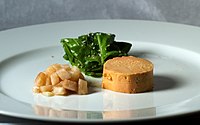Portal:France/Featured article/2012/05
Foie gras (French for "fat liver") is "the liver of a duck or a goose that has been specially fattened by gavage" (as defined by French law). Foie gras is one of the greatest delicacies in French cuisine and its flavour is described as rich, buttery, and delicate, unlike that of a regular duck or goose liver. Foie gras can be sold whole, or prepared into pâté, mousse, or parfait, and is typically served as an accompaniment to another comestible, such as toast points or steak.
The technique of gavage dates as far back as 2500 BC, when the ancient Egyptians began keeping birds for food and deliberately fattened the birds through force-feeding. Today, France is by far the largest producer and consumer of foie gras, though it is produced and consumed worldwide, particularly in other European nations and the United States.
In modern foie gras production, force feeding takes place from 12−18 days before slaughter. The duck or goose is typically fed a controlled amount of corn mash through a tube placed in the animal's esophagus. Due to this force feeding procedure, and the possible health consequences of an enlarged liver, animal rights and welfare organizations and activists regard foie gras production methods as cruel to animals. Foie gras producers maintain that force feeding ducks and geese is not uncomfortable for the animals nor is it hazardous to their health. Scientific evidence regarding the animal welfare aspects of foie gras production is limited and inconclusive. Foie gras production is illegal in a number of countries and other jurisdictions.

